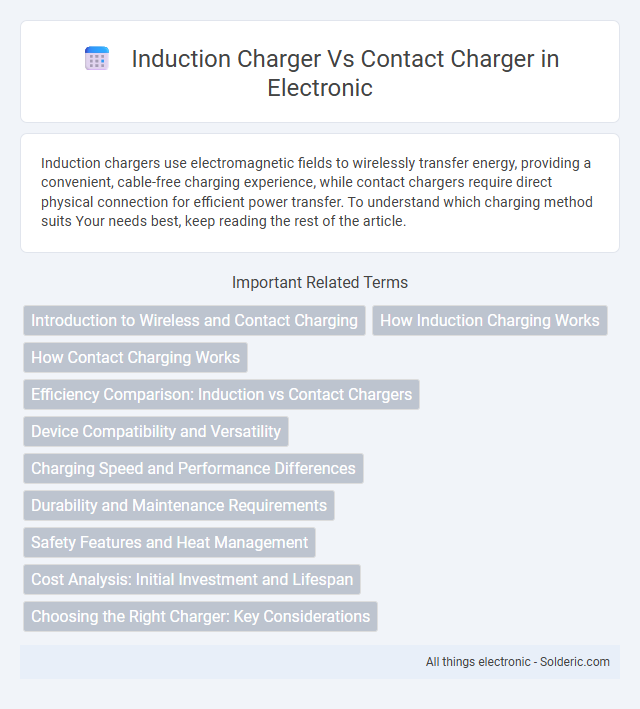Induction chargers use electromagnetic fields to wirelessly transfer energy, providing a convenient, cable-free charging experience, while contact chargers require direct physical connection for efficient power transfer. To understand which charging method suits Your needs best, keep reading the rest of the article.
Comparison Table
| Feature | Induction Charger | Contact Charger |
|---|---|---|
| Charging Method | Wireless electromagnetic induction | Direct electrical contact via connectors |
| Speed | Slower, typically 5W to 15W | Faster, up to 100W+ depending on charger |
| Convenience | Easy alignment, no cables needed | Requires physical plug-in connection |
| Durability | No wear on connectors | Wear and tear on contact points |
| Compatibility | Requires compatible device and charger | Wider universal device support |
| Energy Efficiency | Lower due to energy loss in induction | Higher efficiency, less energy loss |
| Safety | Safe, no exposed connectors | Potential short-circuit risk if damaged |
| Cost | Generally higher due to technology | Lower cost and widely available |
Introduction to Wireless and Contact Charging
Induction chargers utilize electromagnetic fields to transfer energy wirelessly between a charging pad and a compatible device, offering convenience and reducing cable clutter. Contact chargers require physical connection via cables and ports, ensuring faster and more efficient power transfer with minimal energy loss. Wireless charging suits everyday use with moderate power needs, while contact charging remains preferred for rapid and high-capacity device charging.
How Induction Charging Works
Induction charging uses electromagnetic fields to transfer energy between two coils--one in the charger and one in your device--allowing wireless power transmission without direct contact. This method relies on magnetic induction to generate an electric current in the receiver coil, converting it into usable power for charging your battery. Unlike contact chargers that require physical connectors, induction chargers offer a seamless and convenient way to power devices while reducing wear and tear.
How Contact Charging Works
Contact charging works through direct physical contact between the charger's conductive pads and the device's charging points, allowing efficient electrical current transfer with minimal energy loss. This method relies on metal contacts aligned precisely to ensure a stable connection and rapid power delivery. Your device charges faster and more reliably with contact charging compared to induction chargers, which use electromagnetic fields without direct contact.
Efficiency Comparison: Induction vs Contact Chargers
Contact chargers deliver higher energy transfer efficiency, typically exceeding 90%, due to direct electrical connections minimizing energy loss. Induction chargers operate around 70-80% efficiency, as energy is transferred wirelessly through electromagnetic fields, causing heat dissipation and alignment sensitivity. Choosing between them depends on prioritizing charging speed and efficiency (contact) or convenience and portability (induction).
Device Compatibility and Versatility
Induction chargers offer broad device compatibility by supporting any gadget equipped with a Qi wireless charging standard, eliminating the hassle of multiple cables. Contact chargers require specific connectors tailored to each device, limiting versatility and convenience. You can benefit from induction chargers' adaptability to power smartphones, earbuds, and smartwatches without swapping charging accessories.
Charging Speed and Performance Differences
Induction chargers typically offer slower charging speeds compared to contact chargers due to energy loss through electromagnetic fields and less efficient power transfer. Contact chargers deliver direct electrical connection, resulting in faster and more consistent charging performance with lower energy waste. Devices using contact chargers often experience reduced charging times and improved overall efficiency compared to induction-based charging systems.
Durability and Maintenance Requirements
Induction chargers typically offer greater durability due to the absence of physical connectors, reducing wear and tear from frequent plugging and unplugging. Contact chargers rely on metal pins or contacts that can corrode or accumulate debris, increasing maintenance needs over time. If you prioritize low maintenance and long-term reliability, an induction charger may better suit your durability expectations.
Safety Features and Heat Management
Induction chargers offer enhanced safety features through wireless energy transfer, reducing the risk of electric shocks and short circuits commonly associated with contact chargers. They often incorporate advanced heat management technologies like temperature sensors and automatic shutoff to prevent overheating during charging. Your device remains protected with induction charging's ability to minimize direct contact and effectively dissipate heat for safer, more reliable power delivery.
Cost Analysis: Initial Investment and Lifespan
Induction chargers typically have a higher initial investment than contact chargers due to their advanced wireless technology and sophisticated components. The lifespan of induction chargers can be shorter because of potential coil degradation and heat generation, while contact chargers often last longer with minimal maintenance. Your decision should factor in the trade-off between convenience and long-term cost efficiency based on usage patterns.
Choosing the Right Charger: Key Considerations
Choosing the right charger depends on your device's compatibility, charging speed, and convenience preferences. Induction chargers offer wireless charging by creating an electromagnetic field, ideal for reducing wear on charging ports and enabling easy placement, while contact chargers generally provide faster, more efficient power transfer through direct physical contact. Consider your daily usage, device design, and whether portability or rapid charging is your priority to make the best choice for your charging needs.
induction charger vs contact charger Infographic

 solderic.com
solderic.com